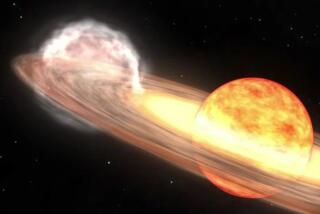Supermassive black hole creates awesome ‘fireworks display’ in space
- Share via
Happy Fourth of July, space lovers!
To help you celebrate the holiday, NASA’s Chandra X-Ray Observatory released this image of a galactic “fireworks display” in a galaxy 23 million light years away.
That crazy explosion of color and light in the image above is the NGC 4258 galaxy seen in a variety of wavelengths.
Viewed by the Hubble Space Telescope in optical light, it seems to be a fairly typical spiral galaxy, not so different than our own Milky Way. (Pretend you can’t see the blue and purple colors in the picture above and you’ll see what I mean).
But when astronomers looked at it in X-ray light (blue) and radio light (purple) a whole new spiral structure emerged -- two extra spiral arms that intersect the plane of the galaxy.
But what is causing this structure to occur?
Scientists say that a supermassive black hole at the center of NGC 4258 is spewing powerful jets of high energy particles, and that the jets are producing shock waves when they strike the galactic disk. Those shock waves, in turn, are heating hydrogen gas in the galaxy to millions of degrees and sending it shooting off toward the galaxy’s outer regions.
If this turbulent situation continues, astronomers estimate that the galaxy will run out of gas within the next 300 million years -- a very short time on the cosmic time scale.
Already, they have found that the central area of NGC 4258 is producing stars at a rate that is 10 times slower than in the Milky Way Galaxy.
All this bodes poorly for the long term future of NGC 4258, but hey -- at least it’s going out with a great show!
Have a great, safe holiday!
For more science fun, follow me @DeborahNetburn







